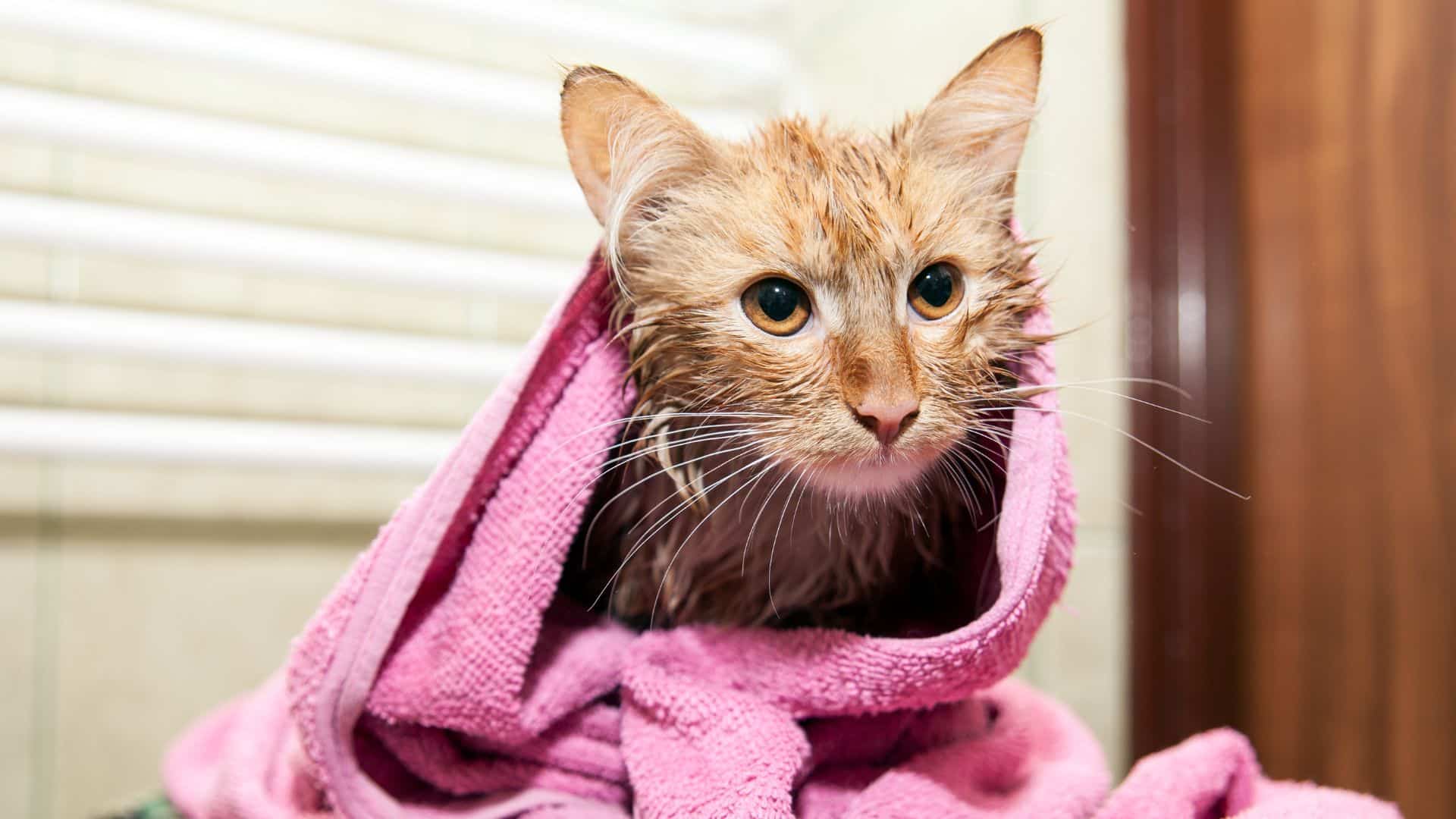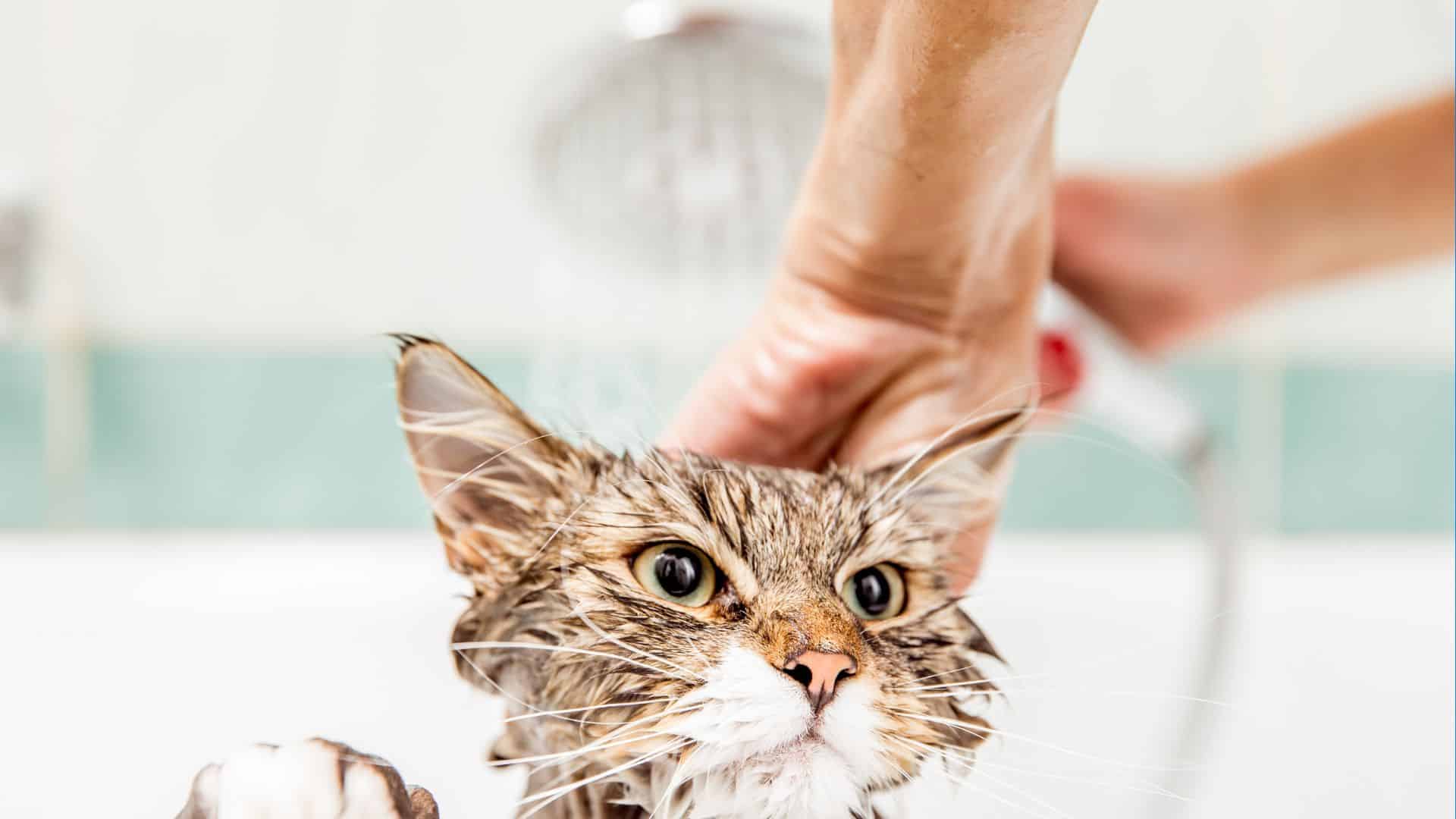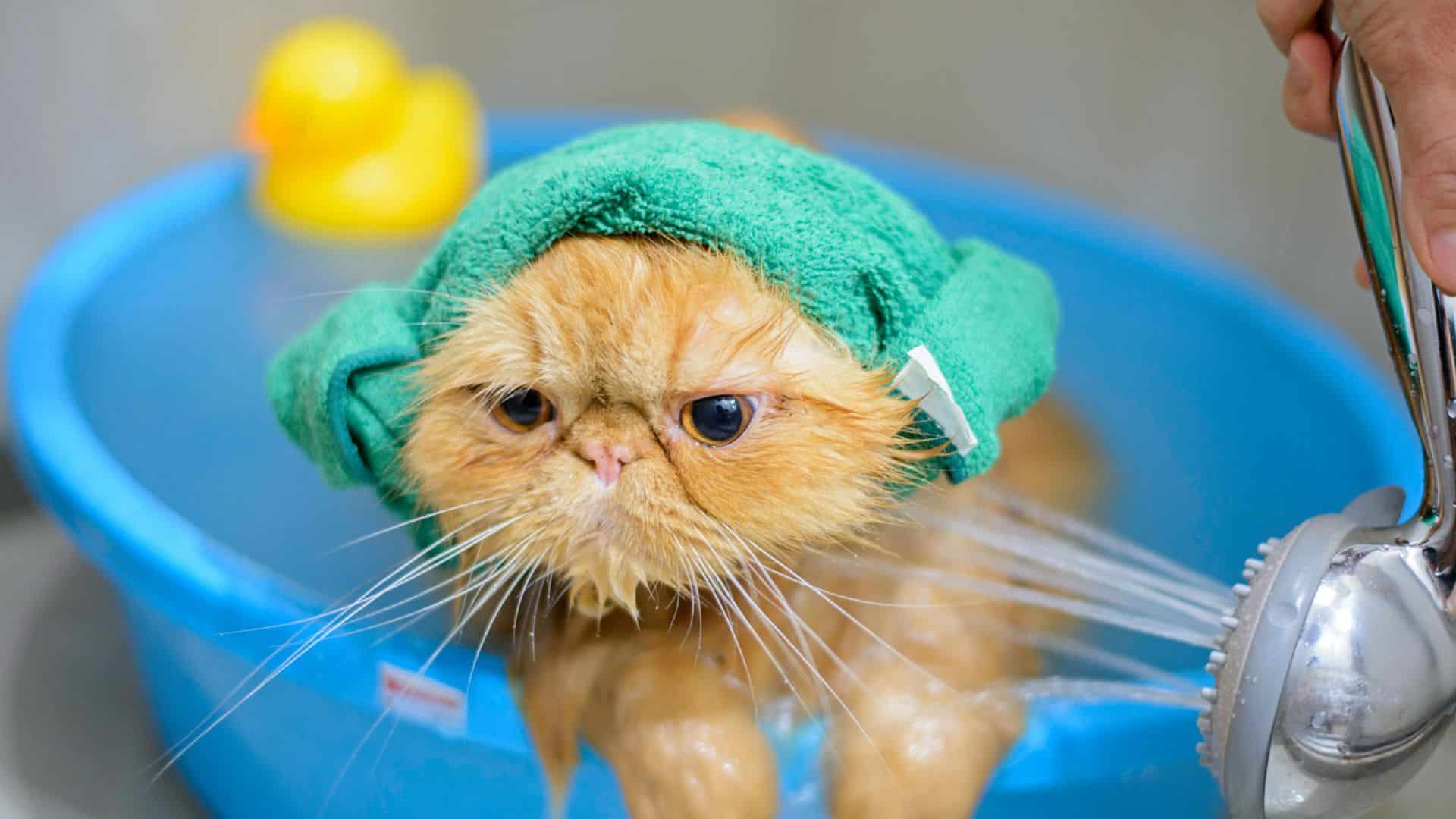Understanding the best way to bathe a cat is crucial for their overall well-being. Cats are known for their meticulous grooming habits, but there are instances when they need a bath. This could be due to health issues, such as skin allergies or fleas, or simply because they got into something dirty.
When it comes to bathing cats, it can be a daunting task. We often think of cats as self-grooming creatures, but sometimes they need a little extra help to stay clean and healthy. Did you know that cats have a natural aversion to water? It’s a common belief that cats hate water, but with the right approach and techniques, bathing a cat can become a manageable task.
It’s important to approach cat bathing with patience and gentleness, as forcing them into a bath can cause stress and potentially harm the bond between you and your feline friend. Using a cat-specific shampoo and warm water, slowly introduce your cat to the bathing procedure, starting with short sessions and gradually increasing the time as they become more comfortable.
When it comes to bathing your cat, it’s important to approach the task with care and patience. Start by preparing the bath area with warm water and a gentle cat-specific shampoo. Keep a non-slip mat in the tub to provide stability for your cat.
Slowly introduce your cat to the water, starting with the paws and gradually wetting the rest of the body. Use a soft cloth or sponge to lather and rinse your cat, ensuring to not to get water in their ears. Finish the bath with a gentle dry and reward your cat with treats and praise for their cooperation.
The Art of Feline Bathing: Tips for a Stress-Free Experience

Do cat baths help? Bathing a cat can be a challenging task for many pet owners. Cats are known for their dislike of water and can become anxious or stressed during the bath.
However, with the right approach and a calm environment, bathing can become a manageable and even enjoyable experience for both you and your feline friend. In this article, we will explore the best way of bathing a cat, providing you with helpful tips and techniques to make the process as smooth as possible.
Understanding Your Cat’s Preferences and Needs
While some cats may tolerate or even enjoy water, others may strongly dislike it. Knowing your cat’s individual temperament will help you tailor the bathing experience to suit their needs. Here are a few things to consider:
- Observe your cat’s behavior around water
- Take note of any signs of fear or anxiety
- Consider their previous bathing experiences, if any
- Test their comfort level with small amounts of water
By understanding your cat’s preferences, you can adapt the bathing techniques to minimize stress and create a positive environment. Remember to give your cat plenty of breaks when grooming.
Preparing the Bathing Area
Creating a calm and comfortable bathing area is essential for a successful cat bath. Follow these steps to set up the perfect bathing environment:
- Choose a small, quiet room where you can bathe your cat
- Place a non-slip mat or towel at the bottom of a sink or bathtub
- Gather all the necessary bathing supplies in advance
- Ensure the water temperature is lukewarm
- Play soft music or use calming pheromone diffusers to create a soothing atmosphere
By creating a safe environment, you can help your cat feel more relaxed during the process.
Pre-Bathing Preparations
Before getting your cat wet, it’s important to take a few preparatory steps to ensure a smooth bathing experience:
- Gently brush your cat’s fur to remove any tangles or mats
- Trim their nails to minimize accidental scratches
- Start by introducing them to the bathing area without water
- Soothe them with soft strokes and reassuring words
These preparations will help your cat become more comfortable and less anxious when it’s time to step into the water.
The Bathing Procedure: Short Hair and Long haired Cat
Now that you’ve laid the groundwork, it’s time to start the actual bathing process. Follow these steps for a successful cat bath:
Step 1: Introduce your cat to the water
Slowly and gently introduce your cat to the water. Use a cup or a handheld sprayer to wet their body, starting with their back and avoiding their head. Speak softly and offer treats or praise to reinforce positive behavior.
Step 2: Apply cat shampoo
Using a cat-specific shampoo, lather your cat’s fur, focusing on areas that need cleaning, such as the belly or paws. Be careful to avoid getting soap in their eyes, ears, or mouth.
Step 3: Rinse thoroughly
Rinse your cat’s fur thoroughly, making sure to remove all traces of shampoo. Leaving any residue behind can cause skin irritation. Use a cup or sprayer to gently rinse their body.
Step 4: Towel dry and reassure
After the bath, carefully lift your cat out of the water and wrap them in a towel. Gently pat them dry, being mindful of their sensitive areas. Offer treats and reassuring words to comfort them.
Step 5: Post-bath relaxation
Allow your cat to relax and self-groom in a quiet, warm area after the bath. Monitor their behavior to ensure they are calm and recovering well from the experience.
Handling Challenging Situations: Keep Your Cat Calm

While some cats may take to bathing relatively easily, others may present more challenging situations. Here are some tips for handling these scenarios:
- Use a cat-specific no-rinse shampoo for cats who absolutely hate water
- Consider consulting with a professional groomer or veterinarian for assistance
- Utilize a calming spray or wipes to help relax an anxious cat
- Take breaks or stop the bathing him or her if your cat becomes overly stressed
Remember to always prioritize your cat’s well-being and adjust your approach accordingly. When bathing a cat, follow these tips to make the experience easier and less stressful:
- Prepare everything beforehand: gather supplies, fill the tub with hot water, and close the bathroom door.
- Trim your cat’s nails beforehand to avoid scratching during the bath.
- Use cat-specific shampoos and products that are gentle on their sensitive skin.
- Start by calmly introducing your cat to the water, using a gentle and reassuring approach.
- Praise and reward your cat with treats after the bath to create positive associations with bathing.
- A scared cat can become aggressive during the actual bath, so you must use glove in case the cat scratches your hands.
Bathing Your Cat like an Expert: Follow the Basic Procedure
Many cats don’t relish the idea of bathing because they are afraid of water. If you really want to clean your cat with water, follow the steps mentioned below:
- Use a cat-friendly shampoo and nothing else. Soaps and shampoos designed for humans or detergents have active chemicals. It will damage the fur of your pet and make your cat sick.
- Use a kitchen sink for bathing your cat and put bath mat or towel in it. This will prevent your cat from slipping. The kitchen sink is a small space and will help you to hold the pet firmly without escaping.
- Don’t use a bathtub because it is slippery and your cat will not be able to stand properly. Besides, there is plenty of free space from where your cat can escape. You will not be able to hold your pet firmly.
- The sink should be filled with lukewarm water up to seven cm. Use the water to dampen the fur lightly. Take a small amount of shampoo and rub it gently into the fur and later it well. Don’t let the shampoo get into the ears, nose or eyes.
- Take a small cup of warm water to rinse the fur thoroughly so that no shampoo is there on the cat’s body. Finally, take out your pet from sink and take a fluffy and thick towel to wrap him.
- Keep him indoor and allow him to dry otherwise the cat’s coat will remain wet. If your cat behaves well during the cat’s bath, then offer him some reward in form of goodies.
- If your cat is longhaired, use a comb or another towel to get her dry. Don’t stop under she is completely damp.
If this is the first time you are going to bathe your cat, then don’t do it alone. The best way to shower a cat would be to ask a friend or relative to help you. One person will hold your pet securely, and the other one can wash and rinse him properly.
People having small kitten don’t need a helper to bathe them until they are full in size. Before baths just make sure, the water is warm and make proper use of cat shampoo. The bathing time should not be more than five minutes otherwise your pet will start protesting.
Don’t forget to give her a treat because she will understand that good thing follow a bath. Make bathing a habit right from a very young age because it will be less stressful for you and your pet.
More Tips to How To Bathe a Most Cats

Cats wash themselves several times during a day but there could come a time when this feline needs a real bath. Feline have a long-standing hatred of water and as an owner, you are starting to know this. If your pet goes outside, you may have to give him a scrub from time to time.
There are a few circumstances when you need to give a bath to your cat. The instances can be to treat fleas, clean up the dirt, remove potential substance etc. It is important that you use some tips regarding the best way on how to bathe a cat.
It will make this process smooth and fruitful. As general rule, do not bathe your cat unless there is a particular reason. Over bathing can strip your pet’s fur of its natural oil and make the skin dry. The fur coat will become brittle and dull.
To minimize the harm and hassles during bath, follow these tips to make bath time a success:
- Claws are deadly weapons, and you will damage your arms badly during the bath. Trim the nails slowly and quickly. Some cats enjoy nail clipping while others consider it as an act of war.
- Plan the bath time accordingly and it should not follow playtime. It is because your cat gets tired after playing and needs to relax before having a bath.
- Start with gentle brushing if you don’t want hairs all over your kitchen sink. Remove all the loose fur from the body before the bath.
- Wet surfaces will make your pet and she will not like it. Put a mat under the sink so that she has something steady to stand on.
- Don’t bathe your cat in a careless manner and avoid touching the sensitive areas during bathing. Make sure that water does not get into the eyes, mouth and ears.
- Use the correct products to bathe your pet. Use shampoos and soaps that are specifically available for cats. Follow the instruction for the shampoo on your pet correctly.
- Rinse your pet thoroughly to make sure that no shampoo remains on the coat. Left over shampoo attracts dirt and make the bath a complete failure
The most important thing you should know before giving your cat a bath is not to get intimidated. It might appear difficult during the first time. After 3, 4 and 5 baths, the process will become easy and both you and pet will start feeling better.
If still your cat hates water, then you can use some disposable wipes, wet cloth or water sprays to bathe her. Make sure that the water does not get into her eyes because cats really hate this thing. These are some of the best ways to bathe a cat smoothly and successfully. You might not enjoy the idea but you will get used to it gradually.
Should You Get Your Cat Wet First?
Remember to take your time and be patient with your cat, as they may not enjoy the bath at first. It’s important to create a calm and soothing environment to help them feel more relaxed and secure. A wet cat automatically shakes off the water from its fur when it feels wet.
This instinctual behavior helps to remove excess moisture and prevent the fur from becoming too saturated. Sink the bathtube with a few inches of warm water and gently place the cat inside. Use a cat safe shampoo to lather its fur, being careful to avoid getting any soap in the cat’s eyes or ears.
If your cat is particularly resistant to being bathed, consider using dry shampoo or seeking professional help. Regular grooming and bathing can help keep your cat clean and healthy, while also strengthening the bond between you and your furry friend.
You can get cat or dog shampoo at your local pet store if you bathe your cat regularly. Pet stores have different brands and types of shampoo specifically formulated for cats and dogs, ensuring their unique needs are met. Additionally, pet store employees can provide helpful recommendations based on your cat’s specific coat type or any skin sensitivities they may have.
Long vs Short Haired Cats

Long haired breeds may loose hair more frequently and require more grooming compared to short haired breeds. However, their luxurious coats can also provide them with extra insulation and protection against the elements.
Use cat wipes to help keep their fur clean and free from mats. Additionally, regular brushing can help prevent hairballs and reduce shedding in long haired cats. Pet wipes can also help to remove dirt and debris from their fur.
If you have more than one cat, you can also consider separating them during grooming sessions to avoid any potential conflicts or stress. It is important to note that short haired breeds may still require regular grooming to maintain a healthy coat and prevent matting, although they generally shed less and require less maintenance compared to long haired breeds.
A cat licks itself to groom and clean its fur, but this may not always be enough to keep their coat in optimal condition. Grooming also provides an opportunity for owners to check for any skin issues or abnormalities that may require veterinary attention.
When you bathe cats, it is important to use cat-specific shampoos and thoroughly rinse them to avoid any irritation or residue. Additionally, it is crucial to handle cats with care during grooming sessions, as they can be sensitive to touch and may become stressed or agitated if handled too roughly.
Frequently Asked Questions
Are you unsure about the best way to bathe your cat? We understand that it can be a challenging task. To assist you, we have compiled a list of frequently asked questions about cat bathing and provided detailed answers to ensure a safe bathing experience for both you and your feline friend.
1. How often should I bathe my cat?
Unlike dogs, cats are usually capable of grooming themselves and do not require frequent bathing. In general, you only need to bathe your cat if they have a specific issue or condition that requires it, such as excessive dirt, a strong odor, or fleas. It is recommended to consult with your veterinarian to determine the appropriate frequency of bathing for your cat.
When bathing is necessary, aim to keep it infrequent to prevent stripping the natural oils from your cat’s fur and causing skin problems. Most cats can go their entire lives without experiencing a full bath as long as they maintain regular self-grooming habits.
2. How can I prepare my cat for a bath?
Preparing your cat for a bath is crucial to ensure a smooth and stress-free experience. Start by gathering all the necessary bathing supplies, such as cat-friendly shampoo, and towels for the bathing area. Place these items within reach before bringing your cat near the bathing area to avoid any last-minute rush.
It is also essential to brush your cat’s fur before the bath to remove any tangles or mats. This will help the water and shampoo reach the skin more effectively. Additionally, trim your cat’s nails prior to the bath to reduce the risk of scratches.
3. How should I handle my cat during the bath?
Handling your cat gently and calmly is crucial during the bathing process. Approach your cat with a calm demeanor and speak to them in soothing tones to help keep them relaxed. It may be helpful to have another person present to assist with holding the cat if needed.
Place your cat slowly into a shallow tub or sink filled with lukewarm water. Supporting them with one hand under their chest and the other supporting their hindquarters can help them feel more secure. Avoid getting water in the cat’s ears and eyes, as it can be uncomfortable for them.
4. Which cat shampoo should I use for my cat?
When selecting a shampoo for your cat, it is important to choose a cat-specific shampoo that is mild and gentle. Avoid using human shampoos or products that contain harsh chemicals, as they can irritate your cat’s skin.
Look for cat shampoos that are specifically formulated for their sensitive skin and pH level. These shampoos are designed to be safe for feline use and will help keep their skin and coat healthy. Consult with your veterinarian for recommendations on the best shampoo for your cat’s specific needs.
5. How can I make the bathing experience less stressful for my cat?
Bathing can be a stressful experience for cats, but there are several things you can do to help minimize their anxiety. Prioritize creating a calm and quiet environment by closing doors and windows to reduce external noise.
Additionally, using a non-slip mat in the bathing area can help your cat feel more secure. Consider using a grooming glove or a soft brush during the bathing process to simulate gentle petting, which may help soothe your cat.
To bathe a cat, start by gathering all the necessary supplies – a cat-friendly shampoo, towels, and a grooming brush. Fill a sink or basin with hot water, making sure it’s not too hot or too cold. Slowly lower your cat into the water, ensuring their head remains above the water level. Gently wet their fur, avoiding the cat’s face and ears.
Lather up the shampoo and carefully massage it into their coat, working from the cat’s neck down to the tail. Rinse thoroughly, making sure to remove all the soap. Lastly, pat your cat dry with a towel, offering treats and praise throughout the process to make it a positive experience.
Last Updated on 16/03/2025 by Karen Snow
Hi! I’m Karen and a certified dog lover. As a freelance writer and blogger, I do my best to squeeze in some time with my dogs, learning more about the way they act and how I can make sure that they continue to stay well-cared for by yours truly.
My dogs have helped me through a lot, and this is my way of giving back to them! Besides animals, I also love to travel and cook, having explored my country’s restaurants and unique places. Follow me as I show you all the amazing tips and bits of information I learn along the way about our furry friends!

thanks for share the tip